ARTH 127 Final Study Guide
1/16
There's no tags or description
Looks like no tags are added yet.
Name | Mastery | Learn | Test | Matching | Spaced |
|---|
No study sessions yet.
17 Terms
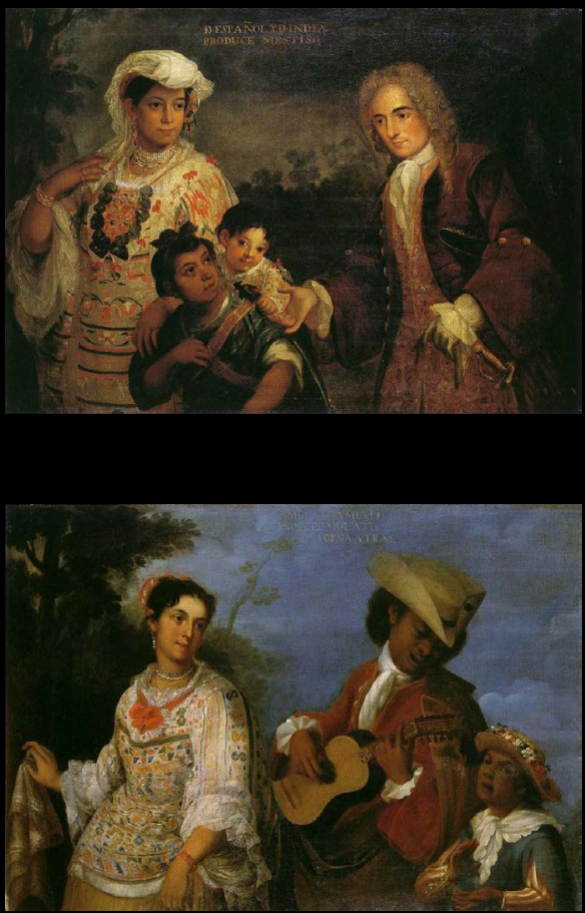
What term do we use to generically refer to this type of painting produced in colonial Mexico? Discuss briefly the subject matter, the intended audience, and the function of this type of painting
Identify:
Rodriguez Juarez’s Casta Paintings: Spaniard and Indian Produce a Mestizo; Mulatto, and Mestiza produce a Mulatto Return-Backwards
Term:
Casta Painting
Subject matter:
Family groups/units: mom, dad, and usually one child, over 100 series of casta paintings
Starts with spanish man then native american women and their mestizo child
Follows fashion of their time
Some negative words, showed labor and activities
Two potential models, holy family(mary, joseph, jesus) or a book about China from Jesuits with 3 figures inside
Intended Audience:
Viceroys, church officials, crown authorities, mexican elites, were to be part of royal cabinet of natural histories
Function:
Showed difference of social status between the top and bottom, followed fashion during their time, showed activities and labor, racial mixing, greatness of mexico, misbehavior and harmony between groups, showed skin color, clothes, manual work, some clothes would be tattered, comparison between top and bottom.
Problems such as unable to identify racial groups or intermixing, visualized well ordered and control under menstruation, intermixing cannot be stopped
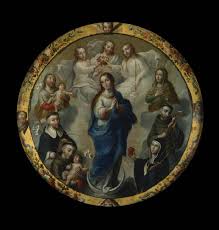
What is a nun’s shield? Explain its function, and usual decoration.
Answer:
Large, circular piece of jewelry that nun’s wear on their chest. Some religious orders had these shields like those devoted to the Immaculate Conception.
Function:
Symbolized the role of a bride for Christ, but also advertised wealth. Also helped identify what religious order they were from. Devotional aids to prayer, emphasized a nun’s piety
Usual Decoration:
Decorated with Virgin Mary as a model for nuns to follow, some have episodes of Mary’s life, some have Virgin Mary and other holy figures.
Made with a variation of materials like mother-of-pearl, silver, oil or watercolor or embroidered, copper, etc.
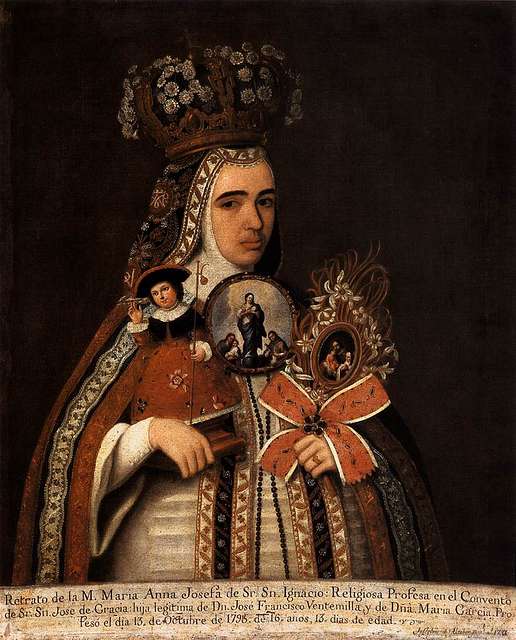
Identify this work. Using this work as an example, explain briefly the purpose and subject matter of this unique type of portrait as well as the symbolism of the multiple artifacts here depicted.
tesIdentify:
Alcibar, Profession Portrait of Creole Nun with nun’s shield
Purpose:
Portraiture of nun’s that were painted for the families when woman took vows to join their religious order who left their families behind, meant to be kept in their houses
Spoke of wealth and status of their family, were very expensive to send daughter to commons, dowries were high
Shown to visitors
Subject matter:
Crowned-Nuns that were unique to Mexico, full length, ¾ pose, or half length
Wore profession habits correlating with their religious order
Floral props and crowns
Symbolism of artifacts:
Floral staff/crown: glory of immortality won by female chastity and thus relates to a nun’s virginal status
Doll: Statue of baby Jesus suggest nun will perform the role of a mother
Ring: Shows devotion to Jesus as being married to them, taking their vows as a bride of Jesus
Insignia Panel: Represent the virgin mary, a model for nuns, spiritual model to follow, can also portray Mary’s life
What two oils did artists use for the production of lacquerware in colonial Mexico, and to what objects was lacquer usually applied? Also, explain the influences that converged in the decoration of this work by Cerda.
tes
What is a bucaro de India and why were they highly regarded across the Atlantic?
What does this 17th century biombo represent (both sides) and what message does it aim to transmit? Also, who was the audience of this kind of artifact in colonial Mexico?
Identify this saint and explain briefly how his history served the creole cause in 17th and 18th century colonial Mexico. Also, describe the estofado technique used here by the artist.
Identify the subject matter. What is the origin of this devotion and how is it related to Colonial Mexico?
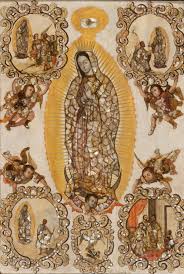
Along with oil paint and wood for the frame, what other technique was used to create this Mexican (provide the name and the technique and its origin)? Also, describe briefly the subject matter of this work, explaining everything within the painting (iconography, content, symbols, …) and its connection to issues of devotion and identity in Colonial Mexico.
Identify:
Miguel Gonzalez’s Virgin of Guadalupe
Other technique:
Enconchado, also known as mother-of-pearl, which were inlaid and would reflect the shine and shimmer to emphasize the sacredness and importance
Subject matter:
Virgin of Guadalupe, in the four corners depicts the story of Juan Diego.
Explain everything:
Virgin of Guadalupe where she reveals herself to Juan Diego asking him to go to the bishop, Juan de Zumarraga and ask for a church to be built on the hill in her honor to which the bishop did not believe him until on the fourth request where she appeared on Juan Diego’s tilma to which Zumarraga recognized and built the church.
Guadlupe is standing on a crescent moon which an almond shape aura behind her with a crown of 12 stars on her head
Corners has scenes carried by angels that represent the moments in the story, upper left Juan Diego is led to the Virgin Mary by angels, upper right, he has a vision of mary
Lower left he takes leave with virgin mary, lower right he reveals the miraculous image to the bishop and others.
Below is an eagle perched on a cactus which symbolized the founding of Tenochtitlan
Above is a dove representing the Holy Spirit surrounded by a golden aura
Connection to issues of devotion and identity:
Official patronage of Mexico City and New Spain
A Way to convert Native Americans to Christianity
Incorporated from the book of psalms as if to say mexico was the chosen land, mexicans were chosen by god
Creoles saw themselves as second class citizens while Spaniards were given important positions, wanted to say that Mexico was part of the spanish empire and not looking for independence, wanted to be recognized by the monarchy as an important part of the Spanish empire
Was use to campaign such as the revolt of farmers and Cesar Chavez and using Guadalupe to protest
What important devotion does this painting represent? Explain briefly the doctrine, its visual representation by colonial Mexican artists, and the sources/models used to craft these images of Mary.
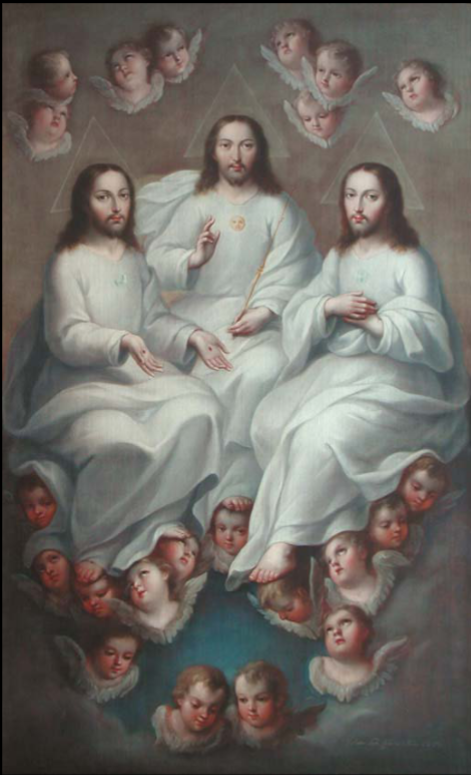
Identify this subject matter. How did this colonial Mexican version differ from other compositions with the same content completed in early modern Europe? For what reasons did Novohispanic artists modify this iconography?
Identify:
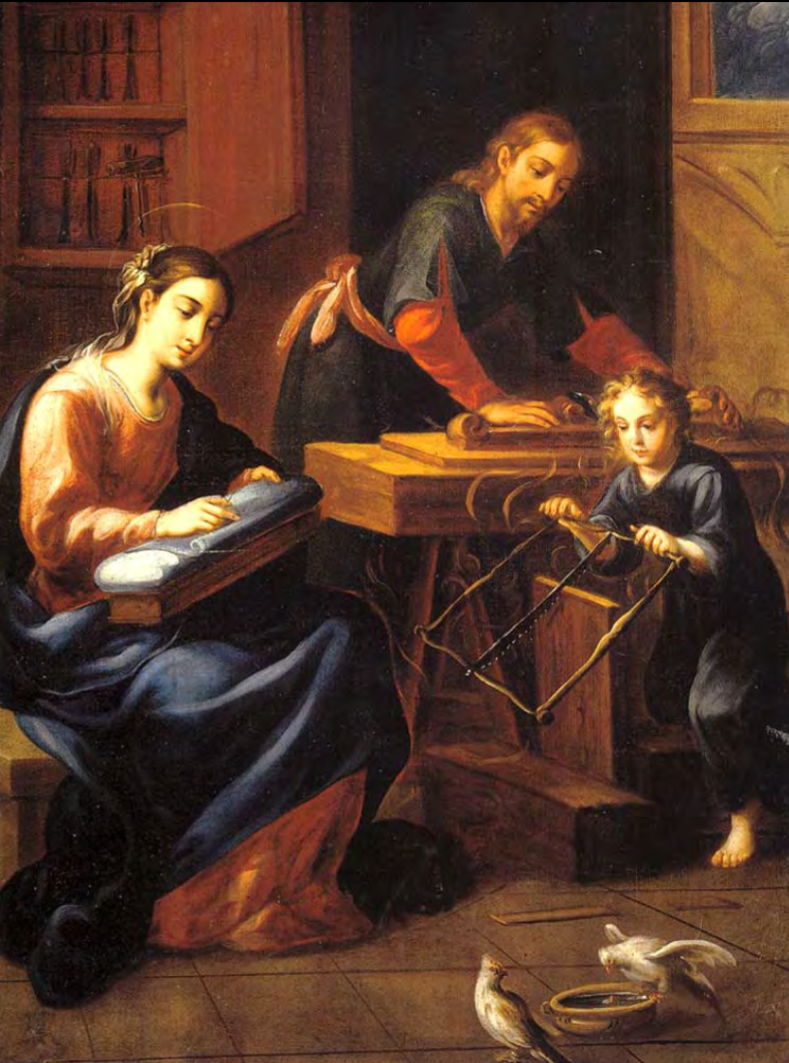
Identify this subject matter. What did this image aim to transmit to its audience in colonial Mexico?
Identify:
Rodriguez Juarez, The Holy Family, 18th century, oil on canvas
Aim to transmit:
Ideal family for all races, working for their benefit and for God, promoted devotion to Jesus and his parents, family values, role of each member in society according to gender and age
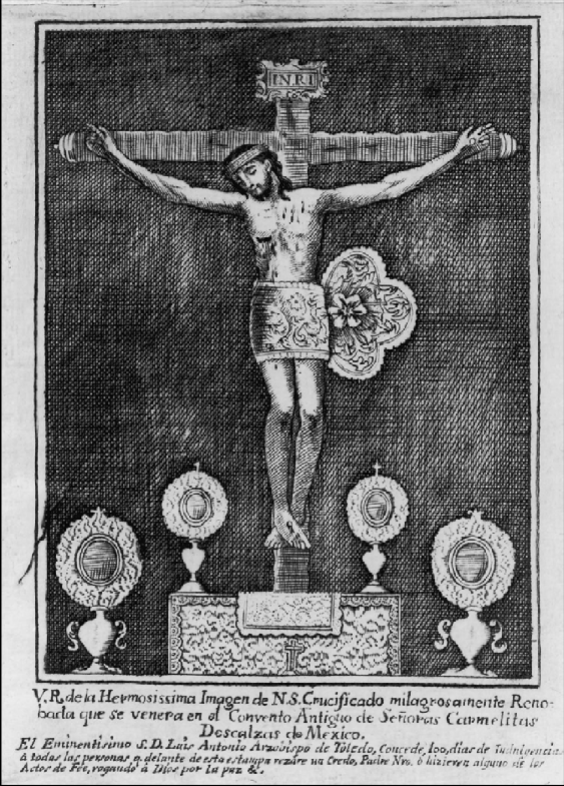
How did prints, such as this one, contribute to promote the cult to certain religious images?
Identify:
Engraving of the Christ of Ixmiquilpan or Santa Teresa
Contribution to promote cults:
Because it was seen as a miraculous image that can perform miracles, it attracted more pilgrims from different parts of colonial mexico and copies were made, painting and prints. Promote devotion to this image. Thousands of copies were made to narrate this piece.
Considered 100 days of indulgences to all those who reside a prayer or an act of faith in front of this print praying to God
Prints that were considered true copies were receiving power of the original miraculous images, praying in front of this work would reward the person that own these work indulgences, indulgences sold by the catholic church
They were used by the church to offer an opportunity for the congregation for the faithful to receive forgiveness.

What do we call these replicas of miraculous images painted during the 18th century? What is the story of this particular devotion to Christ?
Identify:
Ibarra’s Christ of Ixmiquilpan
Call these replicas of miraculous images:
Statue painting, artist is reproducing exactly the original statue but not only the statue itself, but the niche where the statue was with a number of items like silver works, vases, artifacts placed in the altar
Story of this:
The statue was in a terrible condition by the early 17th century, miraculously in the morning, it appeared to the statue completely renovated, completely restored. The statue had restored itself.

In works such as this Crucifixion, how did colonial Mexican artists enhance the realism of the subject? What items, materials, and techniques were used by sculptors? What did they aim to achieve with this extreme realism in their works?
Identify:
Unknown Artist, Crucifixion, 18th century
How enhance realism of subject?
They used physical items like human or horse hair, clay, flesh tones, cornstalk, gesso, glue.
Items, materials and techniques:
Carving wood, human or horse hair, glass eyes, ivory, crystal for tears and drops of blood, articulated joints which their legs and arms can be moved, encarnacion which are flesh tones
Aim to achieve:
Emphasize dramatic episodes of Christ’s life, his suffering and humanity with bruises and blood, wanted to persuade the audience and inspire devotion and piety
What three major European schools of painting contributed to the formation of colonial painting in Mexico? Elaborate your response, indicating the artistic styles and traditions that impacted the painting of colonial Mexico. Provide the name of at least two European artists whose work crossed the Atlantic Ocean and influenced local Mexican creations.
Three major European schools contribute:
Flemish/Flanders
Italian
Spanish
Elaborate, artistic styles and traditions impact:
Flemish
Province in the netherlands that developed and produced prints as they were easy to carry and a resource for artists with limited access to European art centers
Italian
Spanish artists traveled to Italy to study, learned different styles
Influence of Mannerism
Spanish
Spanish Artists moved to Mexico for better opportunities and market for their art, took advantage of it, created paintings and shipped to Mexico
Provide two European artist’s work influence mexican creations:
Martin De Vos
Flemish artist whose work was attributed to like the Engraving of Saint Michael and the Flight to Egypt
Peter Paul Rubens
Based in Antwerp, artworks circulated through europe and to the americas like Triumph of the Church Through the Eucharist
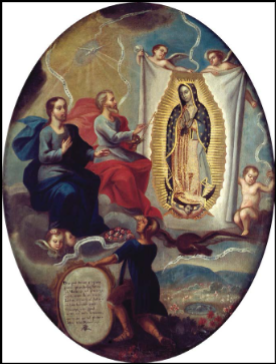
How does this work speak to the originality and invention in the painting of New Spain and the social status of artists in general?
Identify:
Villegas, The Eternal Father Painting the Virgin of Guadalupe
Speak to originality, invention, and social status:
Trying to emphasize their intellectual component of their work, find the originality of the painting in Mexico through their study of their technique, using live models, prints, subject matter, Enconchado technique, etc.
Difference between social status of artists, indigenous artists were oppressed and banned from becoming masters and controlled their works, in Spain artists had to pay for everything, then their work was appraised, rulers had supported painters, some worked with the king for their entire life